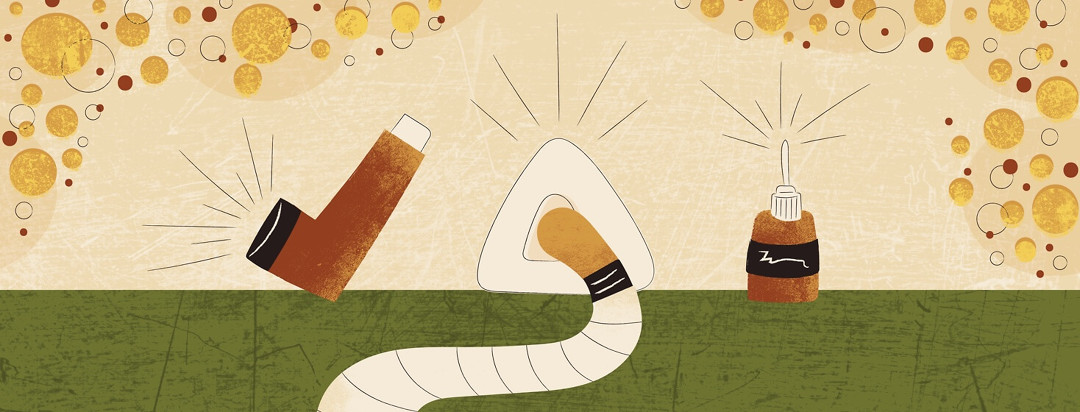Trust Your CPAP During Allergy Season
These days, I’m wiping down everything outside my house. Doorknobs, windowsills, planter pots, car windows… But trust me, I’m no germaphobe. It’s the tree pollen!
Not that I should expect anything different. I live in the Pacific Northwest, after all, a stone’s throw from the Olympic National Forest. Right now, millions of trees are shedding pollen, coating everything in a skim of fuzzy gold.
Springtime allergies bring all the fun: nasal congestion, a runny nose, sneezing, watery eyes, a scratchy throat. Allergies are miserable enough, but if you also have obstructive sleep apnea (OSA) like I do, you might wonder if allergies make CPAP (continuous positive airway pressure) therapy more challenging.
Allergies and OSA
Allergies complicate sleep for people with OSA. Apneas cause the upper airway to collapse as they sleep. These same passages also swell during allergy season. It’s double the trouble!
The solution, however, is not to forgo the use of CPAP therapy during allergy season, but to embrace it.
Together, the following strategies can make CPAP a welcome bedtime partner during allergy season.
Avoid allergens
- Limit pollen exposure. Limit your time outside to days with lower pollen counts. You can check these through online weather sites or apps. Generally, the worst times to go outside: early mornings and on windy, dry days.
- Change your “outside” clothes. Removing clothes after time spent outside helps to keep levels of allergens low inside the home.
- Allergen-proof your home. Vacuum and dust regularly to minimize indoor allergens. Wash bedding more frequently, drying it indoors rather than on the line. Keep windows and doors shut. If using forced air heat or air conditioning, replace dirty filters.
- Keep cats and dogs out of bed. When pets play outdoors, they can carry pollen indoors on their hair or fur, shedding it onto bed linens, couches, blankets, and pillows.
Treat symptoms
- Don’t power through. Work with your doctor to find the right treatment. Note: Some “non-drowsy” antihistamines can cause insomnia, while others can make you especially sleepy.
- Keep saline sprays and inhalers nearby. Saline spray reduces swelling and flushes irritants. If this doesn’t work, try a personal menthol inhaler right before you put on your mask. You can also try a neti pot or nasal wash.
- Use steam. A shower, whole-house humidifier, bath with essential oils, personal humidifier or steamer can all effectively loosen secretions.
- Hydrate. Drinking adequate fluids during allergy season—especially warm drinks like teas and broths.
Trust your therapy
The point of CPAP is to breathe comfortably, without obstruction, through the nose. Using CPAP can reduce scratchy throats, coughs, runny noses, or sneezing. It’s literally designed to provide relief through humidity and filtration.
The humidifier
The CPAP humidifier moisturizes your nasal passages and upper airway. This reduces sneezing and mucus levels. It not only makes CPAP therapy more comfortable and effective, but it also gives your body an extra defense against allergies.
The filter
CPAP machines include multiple filters to ensure you’re receiving the purest possible pressurized air. You can’t get this level of allergen containment if you don’t use CPAP.
Still unsure?
It’s never wise to stop CPAP, even for one night. Once you stop using it, the apneas return. They can lead to the chronic problems you’d hoped to avoid, such as high blood pressure, heart arrhythmias, glucose intolerance, and more.
Also, a sudden halt in CPAP raises red flags with your insurance provider and sleep specialist. You might get a phone call because they’ll wonder why you’re not using it. This is based on the compliance data they receive remotely from your machine every night.
If you pay due diligence with CPAP during allergy season and still feel you’re not getting good sleep, consider these options:
- Try a full-face mask. It allows you to mouth breathe, a temporary measure that helps some people with OSA survive allergy season. Once allergy season passes, return to your preferred mask.
- Consider auto-titrating PAP. Allergy symptoms can alter your pressure needs. Whereas CPAP provides a continuous stream of preset air pressure, auto-titrating PAP operates across a range of pressures, adjusting to your needs all night. PAP machines usually offer both continuous and auto-titrating settings. Ask your sleep specialist if you qualify for this option; they can reset your machine for you.
You have options
Using CPAP during allergy season always gives me relief. In fact, I look forward to bedtime because I know I’ll enjoy eight hours of filtered, moist air to breathe as I sleep, and I’ll awaken feeling better.
If your allergies are problematic, talk to your doctor. They can help you tailor a strategy for overcoming allergies while using CPAP. Having a plan for continuing your therapy uninterrupted is a smart investment in your overall health.
Interested in reading more about getting the most out of your CPAP? Explore our featured collection of tips and tricks for CPAP users.
Community Poll
Do you feel that people living with you have been affected by your sleep apnea symptoms?

Join the conversation